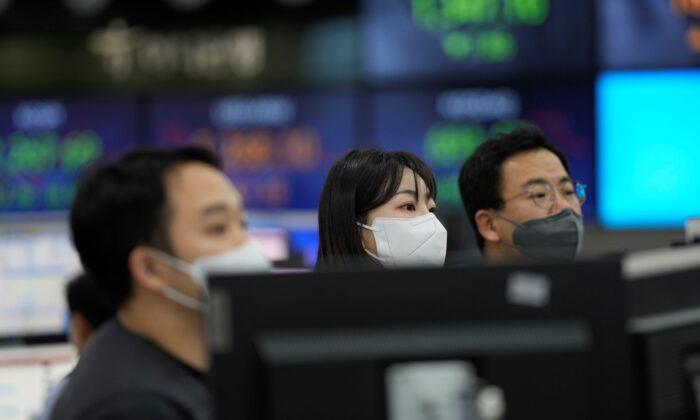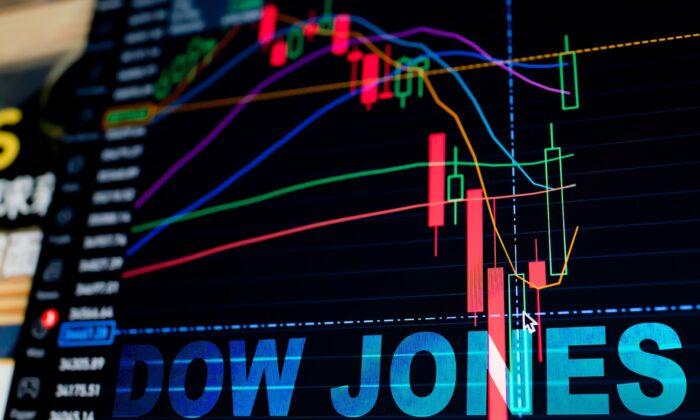BANGKOK—Shares slipped in Europe and Asia on Thursday after benchmarks fell more than 1 percent on Wall Street in the middle of a mostly quiet and holiday-shortened week.
U.S. futures were mixed and oil prices declined more than $1 a barrel.
Investors are watching to see how China’s relaxation of its stringent COVID-19 policies, and the outbreaks of infections that have followed, will affect business activity and travel.
Germany’s DAX gave up 0.3 percent to 13,887.22 and the CAC 40 in Paris lost 0.5 percent to 6,480.47. Britain’s FTSE 100 dropped 0.6 percent to 7,452.45.
The future for the S&P 500 edged 0.1 percent higher, while that for the Dow Jones Industrial Average fell less than 0.1 percent. On Wednesday, the S&P 500 fell 1.2 percent and the Dow industrials declined 1.1 percent. The Nasdaq slid 1.4 percent, while the Russell 2000 gave up 1.6 percent.
In Asian trading Thursday, the Hang Seng in Hong Kong shed 0.8 percent to 19,741.14. The Shanghai Composite index ended 0.4 percent lower at 3,073.70. Tokyo’s Nikkei 225 index lost 0.9 percent to 26,093.67.
The Kospi in Seoul sank 1.9 percent to 2,236.40 after the government reported South Korea’s industrial production fell 3.7 percent from a year earlier in November, worse than forecast and a bigger drop than the 1.2 percent decline in October. Retail sales were down 1.8 percent from the month before.
Australia’s S&P/ASX 200 gave up 0.9 percent to 7,020.10. Bangkok’s SET index gained 0.2 percent.
The worst year since 2008 for the S&P 500 has been winding down with little in the way of data to drive trading. But later Thursday, the U.S. government was due to release jobless claims, a measure of employment that could provide insight into how the economy is faring as the Federal Reserve raises interest rates to quash inflation.
The Fed has already raised its key interest rate seven times this year and is expected to continue raising rates in 2023. The key lending rate, the federal funds rate, stands at a range of 4.25 percent to 4.5 percent, and Fed policymakers forecast that the rate will reach a range of 5 percent to 5.25 percent by the end of 2023. Their forecast doesn’t call for a rate cut before 2024.
With two more days of trading left in 2022, the benchmark S&P 500 is headed for a roughly 20 percent drop for the year, even as profits and margins for companies in the index have hit record heights this year. The Dow is on pace for a 9.5 percent drop, while the Nasdaq is doing much worse, on pace to plunge 34.7 percent.
Southwest Airlines slid 5.2 percent Wednesday as the carrier grappled with the fallout after canceling thousands of flight cancellations. The airline’s CEO said it could be next week before the flight schedule returns to normal. Shares in other airlines also fell. Delta Air Lines dropped 2.8 percent and United Airlines fell 2.4 percent.
Tesla rose 3.3 percent as it stabilized from steep losses it suffered Tuesday.
Early Thursday, U.S. benchmark crude had given up $1.40 to $77.56 per barrel in electronic trading on the New York Mercantile Exchange.
Brent crude, the pricing basis for international trading, shed $1.50 to $82.49 per barrel in London.
The U.S. dollar fell to 133.72 Japanese yen from 134.39 yen late Wednesday. The euro rose to $1.0636 from $1.0613.





